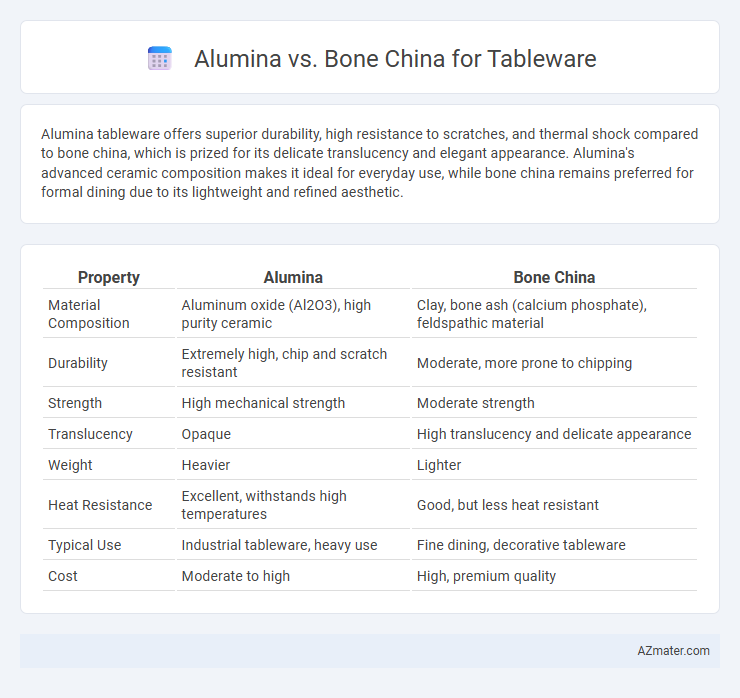Alumina tableware offers superior durability, high resistance to scratches, and thermal shock compared to bone china, which is prized for its delicate translucency and elegant appearance. Alumina's advanced ceramic composition makes it ideal for everyday use, while bone china remains preferred for formal dining due to its lightweight and refined aesthetic.
Table of Comparison
| Property | Alumina | Bone China |
|---|---|---|
| Material Composition | Aluminum oxide (Al2O3), high purity ceramic | Clay, bone ash (calcium phosphate), feldspathic material |
| Durability | Extremely high, chip and scratch resistant | Moderate, more prone to chipping |
| Strength | High mechanical strength | Moderate strength |
| Translucency | Opaque | High translucency and delicate appearance |
| Weight | Heavier | Lighter |
| Heat Resistance | Excellent, withstands high temperatures | Good, but less heat resistant |
| Typical Use | Industrial tableware, heavy use | Fine dining, decorative tableware |
| Cost | Moderate to high | High, premium quality |
Introduction: Alumina vs Bone China Tableware
Alumina tableware offers exceptional durability and chip resistance due to its high alumina content, making it ideal for everyday use and commercial environments. Bone china tableware is prized for its delicate translucency, lightweight feel, and elegant appearance, resulting from its unique blend of bone ash, feldspar, and kaolin. Both materials provide distinct benefits: alumina emphasizes strength and longevity, while bone china highlights refinement and aesthetic appeal.
Material Composition and Properties
Alumina tableware is made from aluminum oxide, providing exceptional strength, scratch resistance, and chip durability, making it ideal for high-traffic dining settings. Bone china consists of bone ash, kaolin, and feldspar, resulting in a translucent, lightweight material revered for its elegance and delicate appearance but with lower mechanical strength than alumina. Alumina's higher thermal shock resistance and non-porous surface contribute to superior longevity and hygiene compared to the more porous bone china.
Manufacturing Process Differences
Alumina tableware is manufactured using alumina ceramic materials, which undergo high-temperature firing above 1600degC, resulting in exceptional strength and durability. Bone china incorporates bone ash, feldspar, and kaolin, fired at lower temperatures around 1200degC to achieve its translucency and delicate appearance. The differing raw materials and firing temperatures directly influence the mechanical properties and finish, with alumina being more chip-resistant and bone china prized for its fine, elegant aesthetic.
Durability and Strength Comparison
Alumina tableware exhibits superior durability and strength compared to bone china due to its high alumina content, which enhances resistance to chipping and thermal shock. Bone china, while prized for its delicate translucency and elegance, tends to be more fragile and prone to cracking under impact or sudden temperature changes. For everyday use requiring robust performance, alumina offers a more resilient option, ideal for both commercial and residential settings.
Weight and Handling Experience
Alumina tableware is significantly lighter than bone china, providing enhanced ease of handling and reducing fatigue during use. Its high-strength ceramic composition ensures durability while maintaining a lightweight feel, ideal for everyday dining or large gatherings. Bone china, though heavier, offers a delicate, refined touch with exceptional translucency, appealing to those prioritizing aesthetic elegance over weight.
Aesthetic Appeal and Design Versatility
Alumina tableware offers a sleek, modern aesthetic with a smooth, durable finish that resists chipping, making it ideal for contemporary settings and minimalist designs. Bone china is prized for its translucent, elegant appearance and delicate, refined texture, lending itself to classic, intricate patterns and traditional table settings. Both materials provide design versatility, but alumina suits bold, minimalist aesthetics while bone china excels in detailed, vintage-inspired styles.
Heat Retention and Thermal Performance
Alumina tableware provides superior heat retention due to its dense ceramic composition, maintaining food temperature longer than Bone china. Bone china, while elegant and lightweight, has lower thermal mass, causing quicker heat loss and less effective thermal insulation. For applications requiring extended heat preservation, Alumina's enhanced thermal performance makes it the preferred material over Bone china.
Price and Market Availability
Alumina tableware typically offers a more affordable price point compared to Bone China, making it an attractive option for budget-conscious consumers. Bone China commands a higher market value due to its premium quality, translucency, and durability, often found in luxury settings and fine dining establishments. Market availability of Alumina is widespread across mass retail and online stores, whereas Bone China is predominantly available through specialty retailers and high-end brands.
Suitability for Everyday Use vs. Special Occasions
Alumina tableware offers exceptional durability and resistance to chipping, making it ideal for everyday use in busy households or commercial settings where frequent handling occurs. Bone china, known for its delicate translucency and elegant appearance, is better suited for special occasions and formal dining due to its finer composition and higher susceptibility to damage. Choosing alumina ensures long-lasting practicality, while bone china enhances aesthetic appeal during celebratory meals.
Environmental Impact and Sustainability
Alumina tableware, made from synthetic aluminum oxide, offers greater durability and longer lifespan, reducing waste compared to bone china, which relies on animal bone ash and non-renewable resources. Bone china's production involves higher carbon emissions due to animal agriculture and intensive firing processes, whereas alumina can be manufactured with less environmental impact through advanced ceramic technologies. Choosing alumina supports sustainability goals by minimizing deforestation and preserving animal populations, while bone china's traditional elegance comes with a larger ecological footprint.

Infographic: Alumina vs Bone china for Tableware
 azmater.com
azmater.com